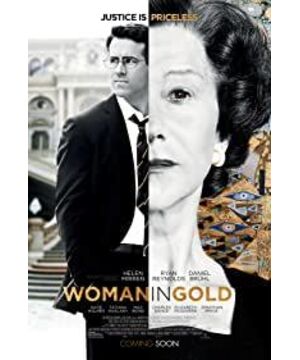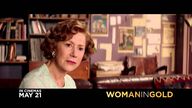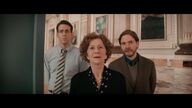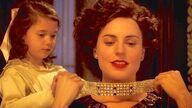Director Simon Curtis' legal film The Woman in Gold is based on a true story. The film tells the story of a Jewish-American fleeing Austria's struggle to recover the Minghua Adele Portrait No. 1 that the Nazis abducted from her home during World War II. This haunting film speaks to the hearts and minds of those who want to get back what was taken away more than 70 years ago.
Fifteen years ago, Maria Altman hired a young lawyer, a family friend, to help her sue the Austrian government to recover the painting, which was on display at the Belvedere Museum in Vienna, home to the world's largest Klimt collection.
Fifteen years ago, Maria Altman hired a young lawyer to help her suing the Austrian government to recover famous paintings. The painting is on display at the Belvedere Museum in Vienna, which has the world's richest collection of Klimtizations.
The film portrays the Austrian curator as an arrogant, unyielding man who refuses to return the painting to Altman because he believes the painting belongs to Austria
. He refused to return the incarnation, believing he was convinced that the painting belonged to Austria. A local Austrian journalist
tells Altman her chances of getting the painting back were infinitesimal because "Woman in Gold" was the Mona Lisa of Vienna. But for Altman, it was a family portrait of her Aunt Adele.
Chances are very slim that this "lady in gold" is Vienna's Mona Lisa. But to Altman, the painting was a family portrait of her aunt Adele.
Filmmaker Curtis intersperses flashbacks of the dramatic last days before Altman's escape from Vienna during the Nazi rule in 1938, with scenes of the contemporary courtroom drama.
Filmmaker Curtis interweaves scenes from the Nazi-ruled 1938 eve of Altman's escape from Vienna and a contemporary courtroom trial. Curtis' film
also addresses the much larger issue of victims' need for justice rendered, even 70 years after the Holocaust.
Now, 70 years later.
“One of the important messages in this film is that we must remember what happened,” he said. “The 21st century is a very complicated and unstable place right now, and it is important to remember some of the lessons and some of the terrible mistakes that were made in the 20th century."
One of the most important messages of the film is that we have to remember what happened. He said, "The 21st century has now reached a stage of confusion and instability, and it is very important to remember the lessons of the past and remember the terrible mistakes made in the 20th century."
Curtis says he took exceptional care to accurately depict scenes from the persecution of the Jews in Austria on the eve of WWII.
Curtis said he was especially careful to accurately show the persecution of Jews in Austria on the eve of World War II.
“We did our best to be as authentic as possible when we were recreating the hideous events of 1938 Vienna. We actually recreated documentary photographs and video of the Germans coming to town, so we did our best to give it as an authentic feel as possible ."
When we were recreating the horrific events that took place in Vienna in 1938, we tried to be objective. We did recreate the German invasion of the city from old photos and video files, and we tried to be as objective as possible.
10. Helen Mirren offers a textured performance as the refined and spirited octogenarian Maria Altman.
Helen Mirren finely interprets the elegant and strong old man Maria Altman
Ryan Reynolds plays Randol Schoenberg, an untried attorney in international law at the time, who in 1998 took the case against Austria to the US Supreme Court, and won. Today, Schoenberg is president of the Holocaust Museum in Los Angeles. He continues his efforts to reclaim art stolen from Jewish families.
Ryan Reynolds played Schoenberg, a young lawyer with no experience in international law defense at the time. He took the case to the US Supreme Court in 1998 against the Austrian government and won. Schoenberg is now president of the Holocaust Museum in Los Angeles. He has been working hard to help Jewish families recover their deprived artworks.
“Immediately after the war, people didn't concentrate on material things,” he explained. “It was rebuilding lives, finding loved ones, figuring out what had happened to them, so I think it did take time for these other issues to subside and for people to focus on the few things that they still could get back and art works are, seven decades later, one of the few things that we can still do something about.”
“When the war was just over, the people didn’t care about material things,” "Life needs to be rebuilt, to find a lover, to find out what happened in the past," he said. "So I think it's going to take some time to calm things down and get people to focus on the few things they haven't gotten back, and art belongs to over 70 years. The few things we can still work on after.”
The world's costliest artwork, Gustav Klimt's portrait of a Viennese lady from 1907 "Adele Bloch-Bauer I," left, hangs in New York's Neue Galerie Museum for German and Austrian Art after being unveiled by its new owner, cosmetics magnate Ronald Lauder, fa
The world's priceless treasure, Klimt and the 1907 painting of the Viennese lady "Ming Hua Adele" is now on display in the German and Austrian Gallery of Art at the Neue Galerie Museum in New York, inaugurated by cosmetics mogul Ronald Lauder.
View more about Woman in Gold reviews










